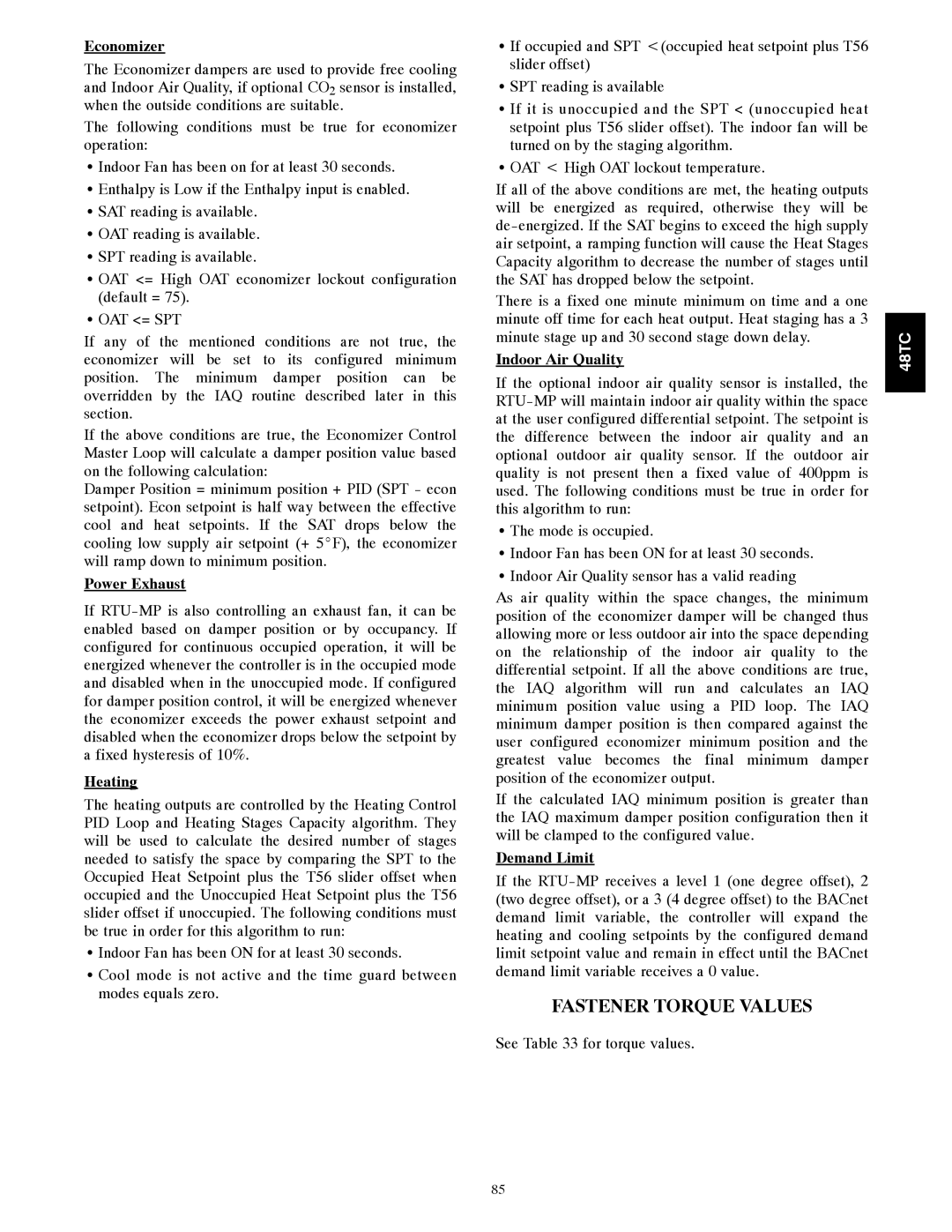Economizer
The Economizer dampers are used to provide free cooling and Indoor Air Quality, if optional CO2 sensor is installed, when the outside conditions are suitable.
The following conditions must be true for economizer operation:
S Indoor Fan has been on for at least 30 seconds. S Enthalpy is Low if the Enthalpy input is enabled. S SAT reading is available.
S OAT reading is available. S SPT reading is available.
S OAT <= High OAT economizer lockout configuration (default = 75).
S OAT <= SPT
If any of the mentioned conditions are not true, the economizer will be set to its configured minimum position. The minimum damper position can be overridden by the IAQ routine described later in this section.
If the above conditions are true, the Economizer Control Master Loop will calculate a damper position value based on the following calculation:
Damper Position = minimum position + PID (SPT - econ setpoint). Econ setpoint is half way between the effective cool and heat setpoints. If the SAT drops below the cooling low supply air setpoint (+ 5_F), the economizer will ramp down to minimum position.
Power Exhaust
If
Heating
The heating outputs are controlled by the Heating Control PID Loop and Heating Stages Capacity algorithm. They will be used to calculate the desired number of stages needed to satisfy the space by comparing the SPT to the Occupied Heat Setpoint plus the T56 slider offset when occupied and the Unoccupied Heat Setpoint plus the T56 slider offset if unoccupied. The following conditions must be true in order for this algorithm to run:
S Indoor Fan has been ON for at least 30 seconds.
S Cool mode is not active and the time guard between modes equals zero.
S If occupied and SPT <(occupied heat setpoint plus T56 slider offset)
S SPT reading is available
S If it is unoccupied and the SPT < (unoccupied heat setpoint plus T56 slider offset). The indoor fan will be turned on by the staging algorithm.
S OAT < High OAT lockout temperature.
If all of the above conditions are met, the heating outputs will be energized as required, otherwise they will be
There is a fixed one minute minimum on time and a one minute off time for each heat output. Heat staging has a 3 minute stage up and 30 second stage down delay.
Indoor Air Quality
If the optional indoor air quality sensor is installed, the
S The mode is occupied.
S Indoor Fan has been ON for at least 30 seconds. S Indoor Air Quality sensor has a valid reading
As air quality within the space changes, the minimum position of the economizer damper will be changed thus allowing more or less outdoor air into the space depending on the relationship of the indoor air quality to the differential setpoint. If all the above conditions are true, the IAQ algorithm will run and calculates an IAQ minimum position value using a PID loop. The IAQ minimum damper position is then compared against the user configured economizer minimum position and the greatest value becomes the final minimum damper position of the economizer output.
If the calculated IAQ minimum position is greater than the IAQ maximum damper position configuration then it will be clamped to the configured value.
Demand Limit
If the
FASTENER TORQUE VALUES
See Table 33 for torque values.
48TC
85
